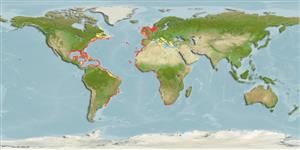Classificação / Names
Common names from other countries
Referência principal
Tamanho / Peso / Idade
Max length : 60.0 cm TL macho/indeterminado; (Ref. 7348); common length : 44.0 cm TL macho/indeterminado; (Ref. 47377); Peso máx. publicado: 6.2 kg (Ref. 40637)
Length at first maturity
Lm 16.3, range 13 - ? cm
Ambiente
; marinhas associadas(os) a recifes; intervalo de profundidade 0 - 100 m (Ref. 7348), usually 0 - 55 m (Ref. 55172)
Clima / Intervalo
Subtropical, preferred 24°C (Ref. 107945); 58°N - 37°S, 98°W - 36°E
Distribuição
Eastern Atlantic: Mediterranean to Moçamedes, Angola. Western Atlantic: Nova Scotia (Canada), Bermuda, and northern Gulf of Mexico to Argentina (Ref. 7251).
Países | Áreas FAO | Ecossistemas | Ocorrências | Introduções
Descrição breve
Espinhos dorsais (total): 3; Raios dorsais moles (total): 26-29; Espinhos anais 0; Raios anais moles: 23 - 26. Tall, with a small mouth and plate like scales (Ref. 35388). Three faint irregular broad dark bars on body; a narrow pale transverse band on chin; small light blue spots on upper half of body and median fins, and irregular short lines ventrally (Ref. 13442).
Categoria na Lista Vermelha da IUCN (Ref. 115185)
Ameaça para o homem
Reports of ciguatera poisoning (Ref. 30911)
Utilização humana
Pescarias: espécies comerciais; peixe desportivo: sim; Aquário: Aquários públicos
Ferramentas
Relatórios especiais
Descarregue XML
Fontes da internet
Estimates of some properties based on models
Phylogenetic diversity index
PD50 = 0.5078 many relatives (e.g. carps) 0.5 - 2.0 few relatives (e.g. lungfishes)
Nível Trófico
4.1 ±0.2 se; Based on diet studies.
Resiliência
Médio, tempo mínimo de duplicação da população 1,4 - 4,4 anos (K=0.18-0.43; tm=1)
Vulnerabilidade
Moderate to high vulnerability (49 of 100)
Categoria de preço
